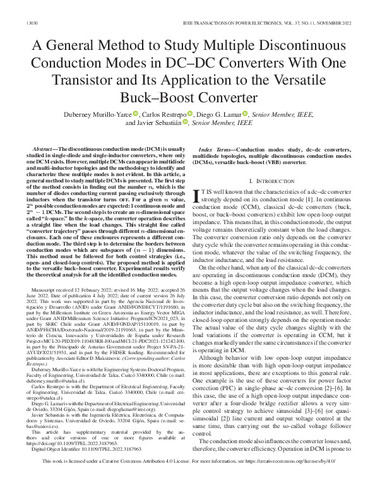A General Method to Study Multiple Discontinuous Conduction Modes in DC–DC Converters With One Transistor and Its Application to the Versatile Buck–Boost Converter
Autor(es) y otros:
Palabra(s) clave:
Conduction modes study
Dc–dc converters
Multidiode topologies
Multiple discontinuous conduction modes (DCMs)
Fecha de publicación:
Editorial:
IEEE
Versión del editor:
Citación:
Descripción física:
Resumen:
The discontinuous conduction mode (DCM) is usually studied in single-diode and single-inductor converters, where only oneDCMexists.However, multipleDCMscan appear in multidiode and multi-inductor topologies and the methodology to identify and characterize these multiple modes is not evident. In this article, a generalmethod to study multiple DCMs is presented. The first step of the method consists in finding out the number n, which is the number of diodes conducting current passing exclusively through inductors when the transistor turns OFF. For a given n value, 2n possible conduction modes are expected: 1 continuous mode and 2n − 1 DCMs. The second step is to create ann-dimensional space called “k-space.” In the k-space, the converter operation describes a straight line when the load changes. This straight line called “converter trajectory” passes through different n-dimensional enclosures. Each one of these enclosures represents a different conduction mode. The third step is to determine the borders between conduction modes which are subspaces of (n − 1) dimensions. This method must be followed for both control strategies (i.e., open- and closed-loop controls). The proposed method is applied to the versatile buck–boost converter. Experimental results verify the theoretical analysis for all the identified conduction modes.
The discontinuous conduction mode (DCM) is usually studied in single-diode and single-inductor converters, where only oneDCMexists.However, multipleDCMscan appear in multidiode and multi-inductor topologies and the methodology to identify and characterize these multiple modes is not evident. In this article, a generalmethod to study multiple DCMs is presented. The first step of the method consists in finding out the number n, which is the number of diodes conducting current passing exclusively through inductors when the transistor turns OFF. For a given n value, 2n possible conduction modes are expected: 1 continuous mode and 2n − 1 DCMs. The second step is to create ann-dimensional space called “k-space.” In the k-space, the converter operation describes a straight line when the load changes. This straight line called “converter trajectory” passes through different n-dimensional enclosures. Each one of these enclosures represents a different conduction mode. The third step is to determine the borders between conduction modes which are subspaces of (n − 1) dimensions. This method must be followed for both control strategies (i.e., open- and closed-loop controls). The proposed method is applied to the versatile buck–boost converter. Experimental results verify the theoretical analysis for all the identified conduction modes.
Patrocinado por:
The authors would like to thank Janeth Alpala from Artificial Intelligence for Electrical Engineering Research Program, SDAS Research Group1, for her mathematical support. This work was supported in part by the Spanish Government under Project MCI-20-PID2019-110483RB-I00.
Colecciones
Ficheros en el ítem





